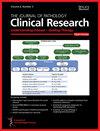A Rare Torsion Case of Polycystic Ovarian Syndrome: A Natural Course with Laparoscopic, Cytological and Pathological Findings
IF 3.4
2区 医学
Q1 PATHOLOGY
引用次数: 0
Abstract
Polycystic ovary (PCO) syndrome cases with adnexal torsion in a natural cycle without ovarian induction are rare, and many torsion cases in PCOs involve pelvic masses, such as uterine fibroids. A 37-year-old woman, gravida two para two, came in an emergency because of lower abdominal pain for 2 or 3 days. PCO was followed in a previous hospital. At a visit in her Douglas pouch, a 7.3 x 4.5 cm mass that was consistent with the point of tenderness was detected by ultrasonography and magnetic resonance images. The patient underwent a semi-emergent laparoscopic surgery for a diagnosis of torsion of the left adnexa. At an abdominal exploration, the left ovary was swollen to approximate 7 cm in size and twisted 360°clockwise. The intraoperative imprint cytology showed the presence of fibrous cells alone, thus the malignancy denied. Histologically, fibrously thickened cortex and multiple follicular cysts due to atretic follicles were found, compatible with PCO. As the patient did not desire to have children and less likely to twist the right ovary, she wanted having low dose pills.一例罕见的多囊卵巢综合征扭转:腹腔镜、细胞学和病理结果的自然过程
多囊卵巢(PCO)综合征在无卵巢诱导的自然周期中伴有附件扭转的病例是罕见的,许多PCOs的扭转病例涉及盆腔肿块,如子宫肌瘤。一名37岁妇女,妊娠2、2段,因下腹疼痛2、3天而急诊就诊。在以前的一家医院进行了PCO随访。在她的道格拉斯育儿袋就诊时,超声和磁共振图像检测到一个7.3 x 4.5 cm的肿块,与压痛点一致。患者接受了半紧急腹腔镜手术,诊断为左附件扭转。腹部探查,左侧卵巢肿大约7cm,顺时针旋转360°。术中印迹细胞学显示仅存在纤维细胞,因此否认恶性肿瘤。组织学上,发现纤维性增厚的皮质和因卵泡闭锁引起的多个滤泡囊肿,与PCO相符。由于患者不想要孩子,也不太可能扭曲右卵巢,她希望服用低剂量的药物。
本文章由计算机程序翻译,如有差异,请以英文原文为准。
求助全文
约1分钟内获得全文
求助全文
来源期刊

Journal of Pathology Clinical Research
Medicine-Pathology and Forensic Medicine
CiteScore
7.40
自引率
2.40%
发文量
47
审稿时长
20 weeks
期刊介绍:
The Journal of Pathology: Clinical Research and The Journal of Pathology serve as translational bridges between basic biomedical science and clinical medicine with particular emphasis on, but not restricted to, tissue based studies.
The focus of The Journal of Pathology: Clinical Research is the publication of studies that illuminate the clinical relevance of research in the broad area of the study of disease. Appropriately powered and validated studies with novel diagnostic, prognostic and predictive significance, and biomarker discover and validation, will be welcomed. Studies with a predominantly mechanistic basis will be more appropriate for the companion Journal of Pathology.
 求助内容:
求助内容: 应助结果提醒方式:
应助结果提醒方式:


